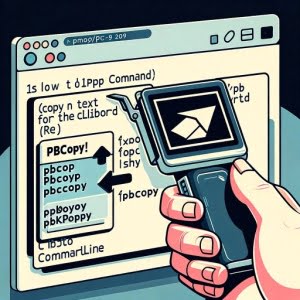Install ‘pbcopy’ Mac Command in Linux: An Alias Guide

Are you looking to install the pbcopy command on your Linux system but aren’t sure where to start? Many Linux users, particularly beginners, might find the task daunting. Yet, pbcopy, a digital clipboard for your terminal, is a tool worth mastering. Although pbcopy is not natively available in Linux, it can be emulated using the xclip command. This command is readily available on most package management systems, making it a straightforward process once you know-how.
In this tutorial, we will guide you on how to install and use the ‘pbcopy’ command on your Linux system. We will show you methods for both APT and YUM-based distributions, delve into compiling xclip from source, installing a specific version, and finally, how to use the pbcopy alternative command and ensure it’s installed correctly.
So, let’s dive in and begin installing pbcopy on your Linux system!
TL;DR: How Do I Install and Use the ‘pbcopy’ Command in Linux?
The
'pbcopy'command is not natively available in Linux, but can be emulated using the ‘xclip’ command. To install ‘xclip’, use the commandsudo apt-get install xclip. To use it as ‘pbcopy’, you can alias it in your bashrc or zshrc file.
sudo apt-get install xclip
echo "alias pbcopy='xclip -selection clipboard'" >> ~/.bashrc
source ~/.bashrc
# Output:
# [No output, but the 'pbcopy' command is now available for use]
This is a basic way to install and use the ‘pbcopy’ command in Linux, but there’s much more to learn about this command. Continue reading for more detailed information and advanced usage scenarios.
Table of Contents
- Installing ‘pbcopy’ Command in Linux: A Beginner’s Guide
- Installing ‘xclip’ from Source Code
- Installing Different Versions of ‘xclip’
- Using and Verifying ‘pbcopy’ Installation
- Exploring Alternative Methods: ‘xsel’ Command
- Troubleshooting ‘pbcopy’ Command Issues in Linux
- Understanding Clipboard Functionality in Linux
- Elevating Your Linux Skills: Clipboard Management and Beyond
- Wrapping Up: Installing the Mac ‘pbcopy’ Command in Linux
Installing ‘pbcopy’ Command in Linux: A Beginner’s Guide
The ‘pbcopy’ command is a handy tool that allows you to copy the output of a command directly to your clipboard. It’s an integral part of the macOS operating system, but unfortunately, it doesn’t come pre-installed in Linux. However, we can emulate ‘pbcopy’ functionality in Linux using the ‘xclip’ command.
‘xclip’ is a command-line interface to X selections (clipboard). It can take input from the command line or from a file and put it into the clipboard, or read the clipboard’s contents to the console or a file.
Installing ‘xclip’ using APT
If you’re using a Debian-based distribution like Ubuntu, you can install ‘xclip’ using the APT package manager. Here’s how you can do it:
sudo apt update
sudo apt install xclip
# Output:
# [The command will output the installation process, and 'xclip' will now be available for use]
After running these commands, ‘xclip’ will be installed on your system. You can verify this by running xclip -version.
Installing ‘xclip’ using YUM
For those using a Red Hat-based distribution like CentOS, you can install ‘xclip’ using the YUM package manager. Here’s the command you need to run:
sudo yum install xclip
# Output:
# [The command will output the installation process, and 'xclip' will now be available for use]
Now that ‘xclip’ is installed, you can alias it as ‘pbcopy’ for easier usage. To do this, you can add the following line to your .bashrc or .zshrc file:
echo "alias pbcopy='xclip -selection clipboard'" >> ~/.bashrc
source ~/.bashrc
# Output:
# [No output, but the 'pbcopy' command is now available for use]
This command adds an alias for ‘pbcopy’ that points to ‘xclip’. The ‘source’ command reloads your bashrc file, making the new alias available immediately. Now, whenever you type ‘pbcopy’ in your terminal, ‘xclip’ will be executed instead, providing the same functionality as the original ‘pbcopy’ command on macOS.
Installing ‘xclip’ from Source Code
If you prefer to compile ‘xclip’ from source code, you can do so by following these steps:
sudo apt-get install git libx11-dev libxmu-dev
# Clone the xclip repository
git clone https://github.com/astrand/xclip.git
cd xclip
# Compile and install
make
sudo make install
# Output:
# [The command will output the compilation and installation process, and 'xclip' will now be available for use]
Installing Different Versions of ‘xclip’
Installing from Source
If you need to install a specific version of ‘xclip’ from the source, you can do so by checking out the relevant tag in the Git repository before compiling. Here’s an example of how you can install version 0.13:
# Clone the xclip repository
git clone https://github.com/astrand/xclip.git
cd xclip
# Check out the relevant tag
git checkout 0.13
# Compile and install
make
sudo make install
# Output:
# [The command will output the compilation and installation process, and 'xclip' version 0.13 will now be available for use]
Installing using Package Managers
Using APT
For Debian-based distributions, you can install a specific version of a package using the apt-get install package=version command. However, ‘xclip’ does not have different versions available in the official repositories.
Using YUM
For Red Hat-based distributions, you can list all available versions of a package using the yum --showduplicates list package command. To install a specific version, use the yum install package-version command. However, ‘xclip’ does not have different versions available in the official repositories.
Version Comparison
The table below summarizes the key changes or features that might lead to wanting one version of ‘xclip’ instead of another.
| Version | Key Changes or Features |
|---|---|
| 0.12 | Initial release with basic clipboard functionalities |
| 0.13 | Added support for multiple X selections |
Using and Verifying ‘pbcopy’ Installation
Using the Command
The ‘pbcopy’ alias command in Linux mimics the behavior of the ‘pbcopy’ command in macOS. Here’s a basic example of how to use it:
echo "Hello, World!" | pbcopy
# Output:
# [No output, but the text "Hello, World!" is now in your clipboard]
Verifying the Installation
To verify that the ‘pbcopy’ alternative is installed correctly and working as expected, you can paste the contents of your clipboard using the ‘xclip -o’ command:
xclip -o -selection clipboard
# Output:
# Hello, World!
This command should output the text that you previously copied to your clipboard, verifying that ‘xclip’ is installed correctly and working as expected.
Exploring Alternative Methods: ‘xsel’ Command
While using a ‘pbcopy’ alias is a popular choice for copying content to the clipboard in Linux, it’s not the only option. Another powerful tool you can use is the ‘xsel’ command.
‘xsel’ is a command-line program that can copy and paste text from and to X11 selection (clipboard). It can operate in two modes: daemon mode (default) and command mode.
Installing ‘xsel’
You can install ‘xsel’ using the APT package manager if you’re using a Debian-based distribution like Ubuntu, or the YUM package manager if you’re using a Red Hat-based distribution like CentOS.
Installing ‘xsel’ using APT
sudo apt update
sudo apt install xsel
# Output:
# [The command will output the installation process, and 'xsel' will now be available for use]
Installing ‘xsel’ using YUM
sudo yum install xsel
# Output:
# [The command will output the installation process, and 'xsel' will now be available for use]
Using ‘xsel’ as an Alternative to ‘pbcopy’
The ‘xsel’ command can be used in much the same way as the ‘pbcopy’ alias. Here’s an example of how to copy the output of a command to the clipboard using ‘xsel’:
echo "Hello, World!" | xsel --clipboard
# Output:
# [No output, but the text "Hello, World!" is now in your clipboard]
To verify that the text was copied to your clipboard, you can use the ‘xsel -o’ command:
xsel -o --clipboard
# Output:
# Hello, World!
Advantages and Disadvantages of ‘xsel’
While ‘xsel’ is a powerful tool, it’s not without its drawbacks. Here’s a quick comparison of the advantages and disadvantages of using ‘xsel’ versus ‘pbcopy’ alias (with xclip).
| Advantages | Disadvantages |
|---|---|
| Can operate in daemon mode, allowing it to persistently monitor the clipboard. | Doesn’t support copying binary data. |
| Supports all three X11 selections (primary, secondary, and clipboard). | More complex syntax compared to ‘pbcopy’. |
Recommendations
If you’re looking for a simple, straightforward way to copy text to the clipboard in Linux, the ‘pbcopy’ alias is probably the best choice. However, if you need more advanced features like the ability to persistently monitor the clipboard, ‘xsel’ might be a better option.
Troubleshooting ‘pbcopy’ Command Issues in Linux
While using the ‘pbcopy’ alias command in Linux, you might encounter some common issues. This section provides solutions to these problems and offers tips for efficient usage.
Issue 1: ‘xclip’ or ‘xsel’ Not Found
If you try to use the ‘pbcopy’ command and receive an error message like “xclip: command not found” or “xsel: command not found”, it means that the ‘xclip’ or ‘xsel’ package is not installed on your system.
To resolve this issue, you need to install the missing package. You can use the installation commands provided in the earlier sections of this guide. Here’s a quick reminder:
# For xclip
sudo apt-get install xclip
# For xsel
sudo apt-get install xsel
# Output:
# [The command will output the installation process, and the package will now be available for use]
Issue 2: ‘pbcopy’ Command Not Working
If you’ve installed ‘xclip’ or ‘xsel’ and added the alias to your .bashrc or .zshrc file, but the ‘pbcopy’ command is still not working, it’s likely that your shell is not reading the alias. This can happen if your .bashrc or .zshrc file is not being sourced when your shell starts.
To fix this issue, you can manually source your .bashrc or .zshrc file using the ‘source’ command:
source ~/.bashrc
# or
source ~/.zshrc
# Output:
# [No output, but the 'pbcopy' command should now work]
Issue 3: ‘pbcopy’ Command Not Persisting Between Sessions
If you find that the ‘pbcopy’ command works during your current shell session but stops working when you start a new session, it’s likely that the alias you added to your .bashrc or .zshrc file is not being read when your shell starts.
To ensure that the alias persists between shell sessions, you can add the alias to your .bash_profile or .zprofile file instead of your .bashrc or .zshrc file:
echo "alias pbcopy='xclip -selection clipboard'" >> ~/.bash_profile
# or
echo "alias pbcopy='xclip -selection clipboard'" >> ~/.zprofile
# Output:
# [No output, but the 'pbcopy' command should now persist between shell sessions]
These are some of the common issues you might encounter when installing and using the ‘pbcopy’/’xclip’ command in Linux. Remember, the key to troubleshooting is understanding the problem and systematically testing potential solutions. Happy troubleshooting!
Understanding Clipboard Functionality in Linux
Before we delve deeper into the ‘pbcopy’/’xclip’ command, it’s essential to understand the clipboard functionality in Linux. The clipboard is a feature that allows temporary storage and transfer within and between applications, via copy and paste operations or drag-and-drop.
In Linux, the clipboard functionality is implemented through a feature of the X Window System called ‘selections’. These ‘selections’ are buffers that hold data that can be manipulated by the user, typically through copy and paste operations.
The Clipboard and Primary Selections in X11
X11, the graphical windowing system used by Linux, supports multiple selections, but the two most common are the ‘clipboard’ and ‘primary’ selections.
# Copying to the clipboard selection
echo "Hello, World!" | xclip -selection clipboard
# Output:
# [No output, but the text "Hello, World!" is now in your clipboard]
# Copying to the primary selection
echo "Hello, Linux!" | xclip -selection primary
# Output:
# [No output, but the text "Hello, Linux!" is now in your primary selection]
The ‘clipboard’ selection is used when you explicitly copy something, for example by right-clicking and selecting ‘Copy’ or by using a keyboard shortcut like Ctrl+C.
The ‘primary’ selection, on the other hand, is used when you select some text with your mouse. You can paste from the primary selection by clicking the middle mouse button.
This difference between the ‘clipboard’ and ‘primary’ selections is one of the unique features of the X Window System. Understanding this difference is crucial for using the ‘pbcopy’ alias command effectively in Linux, as it allows you to control which selection you are copying to.
Elevating Your Linux Skills: Clipboard Management and Beyond
Understanding and using the ‘pbcopy’ (xclip) command is just the beginning. Clipboard management in Linux can be a powerful tool, especially when used in scripting and automation. By combining ‘pbcopy’ with other commands, you can create powerful workflows that can save you time and effort.
Exploring Related Commands: ‘pbpaste’
One command that goes hand in hand with ‘pbcopy’ is ‘pbpaste’. While ‘pbcopy’ copies data to the clipboard, ‘pbpaste’ does the opposite – it pastes data from the clipboard. This command can be incredibly useful when you want to use the data you’ve copied to the clipboard in a script or command.
Here’s an example of how you can use ‘pbpaste’ in a script:
# First, let's copy some text to the clipboard
echo "Hello, World!" | pbcopy
# Now, let's use 'pbpaste' to get that text and write it to a file
pbpaste > hello.txt
cat hello.txt
# Output:
# Hello, World!
In this script, we first copy the text “Hello, World!” to the clipboard using ‘pbcopy’. We then use ‘pbpaste’ to paste that text into a file named hello.txt. Finally, we use the ‘cat’ command to print the contents of the file, verifying that ‘pbpaste’ worked as expected.
Further Resources for Mastering Linux Commands
To further your understanding and mastery of Linux commands, including ‘pbcopy’, ‘pbpaste’, and many others, you can explore the following resources:
- GNU Coreutils: This is the official documentation for the GNU core utilities, which are the basic file, shell, and text manipulation utilities of the GNU operating system. These are the core utilities expected to exist on every operating system.
Linux Command Library: This website provides a comprehensive list of Linux commands, along with detailed explanations and examples for each command.
The Linux Documentation Project Guides: This website offers various guides on different aspects of the Linux operating system, including guides on Bash scripting, system administration, and security.
Remember, the key to mastering Linux commands is practice and exploration. Don’t be afraid to experiment with different commands and options to see what they do. Happy scripting!
Wrapping Up: Installing the Mac ‘pbcopy’ Command in Linux
In this comprehensive guide, we’ve taken a deep dive into the world of the ‘pbcopy’ command in Linux. This powerful tool, while not native to Linux, can be emulated to provide seamless clipboard management in your Linux system.
We started off with the basics, explaining how to install and use the ‘pbcopy’ alias command at a beginner level. We then moved on to more advanced usage, discussing how to install ‘pbcopy’/’xclip’ from source code, how to install different versions, and how to verify your installation.
Along the way, we addressed common issues you might encounter when using the ‘pbcopy’/’xclip’ command, providing practical solutions to help you overcome these challenges. We also explored alternative approaches for copying content to the clipboard in Linux, such as the ‘xsel’ command, giving you a broader perspective on clipboard management.
Here’s a quick comparison of the methods we’ve discussed:
| Method | Pros | Cons |
|---|---|---|
| ‘pbcopy’ | Mimics macOS functionality, easy to use | Not native to Linux |
| ‘xsel’ | Supports daemon mode, three X11 selections | More complex syntax |
Whether you’re a Linux newbie or a seasoned system administrator, we hope this guide has equipped you with the knowledge and skills to effectively use the ‘pbcopy’ command. The ability to manipulate the clipboard from the command line can significantly enhance your productivity and open up new avenues for automation. Happy Linux-ing!


